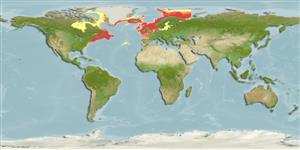Environment: milieu / climate zone / depth range / distribution range
Sinh thái học
Biển Sống nổi và đáy; Ở đại duơng, biển (Ref. 51243); Mức độ sâu 0 - 868 m (Ref. 58496), usually 50 - 150 m (Ref. 4701). Polar; 3°C - 11°C (Ref. 127841); 80°N - 32°N, 95°W - 49°E
Western Atlantic: Nunavut, Hudson Bay to James Bay and Labrador in Canada to New Jersey in USA; rarely to Chesapeake Bay in USA and Bermuda. Eastern Atlantic: Barents Sea, Iceland and Greenland to Spain (Ref. 4701).
Bộ gần gũi / Khối lượng (Trọng lượng) / Age
Maturity: Lm ? range ? - ? cm
Max length : 61.0 cm TL con đực/không giới tính; (Ref. 58426); 42.9 cm SL (female); Khối lượng cực đại được công bố: 9.5 kg (Ref. 4701); Khối lượng cực đại được công bố: 9.5 kg; Tuổi cực đại được báo cáo: 13 các năm (Ref. 54207)
Các tia vây lưng cứng (tổng cộng) : 5 - 9; Các vây lưng mềm (tổng cộng) : 9 - 11; Tia cứng vây hậu môn: 0; Tia mềm vây hậu môn: 9 - 10; Động vật có xương sống: 28 - 29. First dorsal fin present but covered by thick layer of skin forming a characteristic high crest with embedded spines. Bony tubercles present, arranged in 3 widely separated rows of large flattened tubercles on each side of body. Gill openings large, extend- extending below level of upper pectoral fin ray. Pyloric present 36-79. Ventral sucking disc formed by the modified pelvic fin (Ref. 232).
Basically solitary rather than a schooling fish. They exhibit a homing instinct (Ref. 9737). Adults inhabit rocky bottoms but may occur among floating seaweed. They migrate considerable distances in an annual cycle between deeper waters in winter and shallower waters in summer (Ref. 26141). Maximum depth reported at 868 m (Ref. 58426). Epibenthic-pelagic (Ref. 58426). Juveniles are found among algal clumps in bays and fjords moving offshore as they mature (Ref. 96431). During the spawning season the males become reddish in color on the underside, whereas females turn blue-green. Adults feed on ctenophores, medusas, small crustaceans, polychaetes, jelly fish and small fishes. Valued for their eggs, which make an inexpensive caviar (Ref. 9988). Eaten in Nordic countries, marketed fresh or smoked. Male flesh is most demanded and roe is sold fresh (Ref. 35388).
Eggs are laid in large numbers on stony bottoms (Ref. 9900). Male guards egg-mass aggressively.
Stein, D.L., 1986. Cyclopteridae. p. 1269-1274. In P.J.P. Whitehead, M.-L. Bauchot, J.-C. Hureau, J. Nielsen and E. Tortonese (eds.) Fishes of the North-eastern Atlantic and the Mediterranean. UNESCO, Paris. Vol. III. (Ref. 4701)
IUCN Red List Status (Ref. 130435)
Threat to humans
Harmless
Human uses
Các nghề cá: tính thương mại cao; mồi: usually
Các công cụ
Special reports
Download XML
Các nguồn internet
Estimates based on models
Preferred temperature (Ref.
123201): 0.6 - 11.4, mean 7.1 °C (based on 732 cells).
Phylogenetic diversity index (Ref.
82804): PD
50 = 1.0000 [Uniqueness, from 0.5 = low to 2.0 = high].
Bayesian length-weight: a=0.02630 (0.01091 - 0.06342), b=2.99 (2.78 - 3.20), in cm total length, based on LWR estimates for this (Sub)family-body shape (Ref.
93245).
Mức dinh dưỡng (Ref.
69278): 3.9 ±0.0 se; based on diet studies.
Thích nghi nhanh (Ref.
120179): thấp, thời gian nhân đôi của chủng quần tối thiểu là 4.5 - 14 năm (K=0.12; tm=3-5; tmax=13; Fec=100,000).
Prior r = 0.15, 95% CL = 0.10 - 0.22, Based on 1 full stock assessment.
Fishing Vulnerability (Ref.
59153): Moderate to high vulnerability (47 of 100).
Climate Vulnerability (Ref.
125649): Low to moderate vulnerability (26 of 100).
Nutrients (Ref.
124155): Calcium = 14 [4, 76] mg/100g; Iron = 0.419 [0.153, 1.089] mg/100g; Protein = 14 [11, 18] %; Omega3 = 0.423 [0.162, 1.406] g/100g; Selenium = 26.2 [8.8, 69.4] μg/100g; VitaminA = 13.4 [2.4, 72.4] μg/100g; Zinc = 0.52 [0.20, 0.90] mg/100g (wet weight); based on
nutrient studies.
